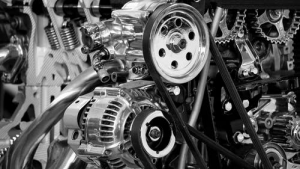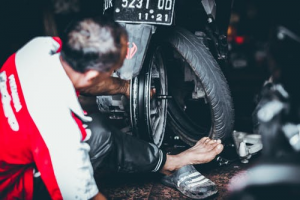
Automotive part marking and traceability is a process that is used to track an automotive product or assembly during its entire life cycle by applying a unique identification that is linked to a database. Traceability is the act of finding out the record, location, and use of an automotive product (for example wheels). As a manufacturer, traceability is a form of insurance to you; it will minimize the cost of the recall campaign and improve your production process. Traceability is currently is a major challenge in the automotive industry. With an increase in the volume of data required for traceability, automotive manufacturers must find a way to store information concerning their products. By tracking your products efficiently, you save on costs significantly, increase overall efficiency that will have a real impact on the image of your company.
For effective traceability, the following are features that any track and trace system must have:
 Direct part marking
Direct part marking
Direct part making involves the creation of permanent marks on an automotive part with the following information: 2D codes, barcodes, serial numbers, date codes, and part numbers. This will ensure traceability of a part throughout its life cycle. The automotive industry commonly uses Laserax lasers to facilitate reliable traceability of parts. Traceability assists in warranty issues, regulatory requirements, and data logging for safety purposes. Apart from laser marking other methods used to produce permanent marks on automotive parts include engraving, coining, embossing, electrochemical etching, laser shot penning, abrasive blasting, dot peen, liquid metal jet, indenting, stencil, and cast.
The following are advantages of permanent part marking:
- There are no consumables
- Accurate and fast part marking, varying from deep marking to light engraving.
- It’s an economical solution since the cost is relatively cheap.
- It provides permanent marking that withstands wear and tear.
- There is high productivity: the process can be automated and connected to a database.
- It provides marking for the entirety of a product’s life: the barcode has data on the model and part number that is useful for future replacement or repair of a product.
- The machine is durable, reliable and designed to withstand the harsh industrial environment.
- The machine has integration capabilities for automated networking.
- A friendly user interface that can be easily programmed.
Code readability and structure
Although 2D codes require image processing software, they are superior to barcode because they have many traceability advantages. 2D codes assist in tracking truck and car parts during manufacturing. When using 2D codes consider the following features:
Requirements and size
For effective readability restrict the physical size of the pixels used. The more pixels in a code reduce the amount of data stored in it.
Inaccuracy Correction Level
The 2D code should have redundant pixels which allow a reader to interpret the code on a part even if a portion of the pixels are illegible or spoilt. Use the Error Correction (EC) level to quantify the inaccuracy level of code.
Choosing Error Correction level
Use a laser marking system (because of their high contrast) to ensure the code has high error correction levels that can withstand harsh industrial conditions. Error correction levels should be selected to optimize each application. Die-cast parts require higher error correction levels to obtain acceptable readability. For automotive parts a correction level of 25% is acceptable.
Advantages of 2D codes over Barcodes
- They store more information that is required for effective part marking.
- They have tunable error correction level that maintains the code’s effectiveness.
- Offer more reliability than barcodes.
Detailed marking
Marking should be detailed in order to: ensure a client can identify parts and their mode, promote your brand, prevent counterfeiting and meet quality standards and regulations.
- Marking of parts should include the following:
- Manufacturer’s logo and name
- Serial number
- Part number
- Manufacturing date
- Location
- Counter
- Shift
- Data matrix code
Vehicle Identification Number
When a vehicle leaves the industry, it is identified by a 17-character number (Vehicle Identification Number, VIN) which is on its registration document. Various components of the vehicle are marked during its assembly: a standard serial number makes each part of the vehicle unique and traceable. The following parts are marked during the manufacturing process:
- Engine
- Wheels
- Shock absorbers
- Chassis
- Nameplates
- Transmissions.
The need for effective traceability has been compounded by the implementation of the Transportation Recall Enhancement, Accountability, and Documentation Act by the National Highway Traffic Safety Administration (NHSTA). It requires automotive manufactures to occasionally file reports to NHSTA in a bid to spot potential safety flaws and various concerns to safeguard drivers. Driven by the automotive industry demands, choosing a system that has permanence/longevity on the markings and the reliability of equipment. There are various traceability systems that are available for the traceability of your product. With the ever mounting pressure in the automobile market, the marking of products has never been as critical as it is today.










